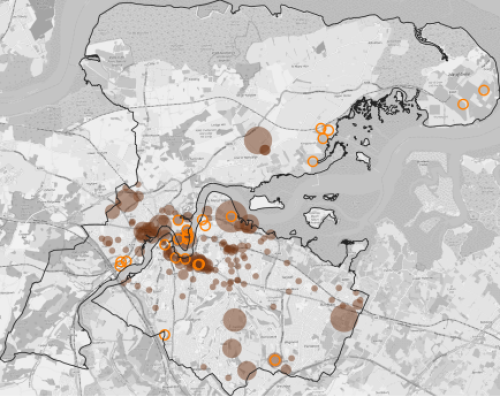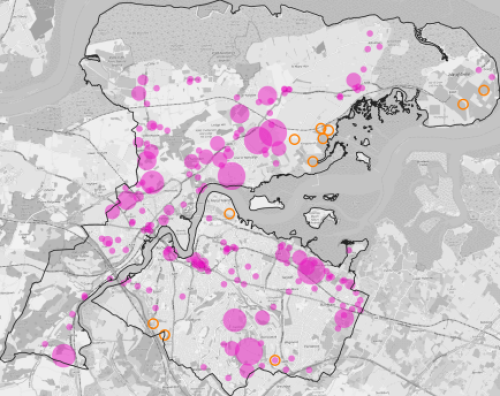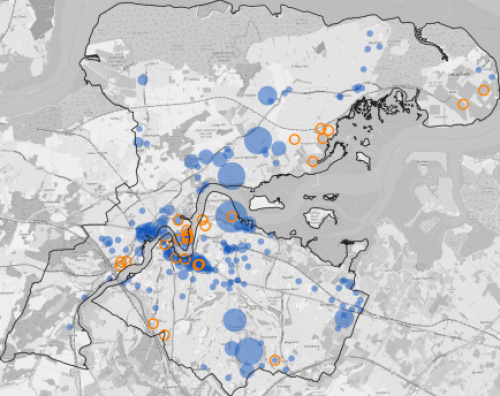Medway Local Plan (Regulation 18, 2024)
3.1 Overview
3.1.1 Three SGOs have been assessed in the Sustainability Appraisal. The SGOs, shown in Figure 1 below, are alternatives to the spatial distribution of growth.
SGO 1 - Urban Focus

SGO 2 - Dispersed Growth

SGO 3 - Blended Strategy

© OpenStreetMap contributors (https://www.openstreetmap.org/copyright)
Contains Ordnance Survey data © Crown copyright and database right 2010-2023.
Figure 1: Spatial Growth Options
3.1.2 SGO 1 seeks to maximise development on brownfield sites in urban centres and waterfront sites, benefitting from good transport links and accessible locations. There would be a focus on increasing density in these urban areas. The urban locations alone would not meet the full growth needed in Medway, so there would also be more limited greenfield development adjoining existing larger settlements, including Strood, Rainham, Lordswood and Hoo. There is strong support in national planning policy for the regeneration of previously developed land, and often a preference from the public for the development of brownfield sites. However, such a reliance on the scale and density of development in urban centres and waterfronts raises issues with potential conflict with design guidance, such as the Chatham Design Code, and heritage constraints. This option also includes the proposed redevelopment of existing employment sites at Chatham Docks and areas of Medway City Estate to residential led mixed use growth. There are potential issues with viability on brownfield sites, and the reliance on this development approach would limit the range of housing types to meet the needs of Medway's communities, such as family homes.
3.1.3 SGO 2 considers more limited land being provided through regeneration and excludes sites such as Chatham Docks and some town centre and waterfront opportunity sites that are not actively being promoted by landowners. This option involves a much higher release of land on greenfield and Green Belt sites, including the Hoo Peninsula, North of Rainham, Medway Valley and sites in proximity to sensitive environmental areas, such as Darland and Deangate. It raises issues of sustainability, as there is likely to be higher reliance on car-based transport, a greater loss of good quality farmland, and wider environmental impacts.
3.1.4 SGO 3 blends regeneration and greenfield development, and is the indicative preferred option. There is a 'brownfield first' focus with regeneration in urban centres and waterfront locations, complemented by range of sites in suburban and rural areas. About half of the development would be on brownfield land. It provides for range of housing and types, and density and heights in regeneration sites would reflect design guidance and heritage constraints, rather than focusing on maximising housing numbers to the detriment of the surrounding amenities and quality.
3.1.5 In considering options for sustainable development in Medway, the Council has sought to direct growth to brownfield sites first. This seeks to make use of previously developed land, secure investment in regeneration, and support the evolution of town centres in the context of structural changes in retail. This continues the regeneration agenda that has been integral to Medway's change and growth in recent years, delivering new homes in accessible locations, and supporting economic growth and new services and facilities. The 'brownfield first' approach closely aligns to the wider policy and development environment, such as the Chatham Design Code, Sun Pier to Star Hill HAZ, and Strood Town Centre masterplan and Riverside Supplementary Planning Document (SPD). However, this focus on the potential of urban regeneration cannot deliver the full quantum and mix of development needed to support the needs of Medway's communities and businesses. The options considered for consultation provide varying approaches to the scale of urban regeneration in Medway's growth strategy.
3.1.6 The Council has carried out a wide review of potential development land across the borough. This has been informed by the iterative Land Availability Assessment. The rural and suburban areas are considered to offer potential for development, and there has been strong promotion of sites by the private sector on greenfield sites in these locations. As Medway has a high level of housing need, the Council needs to consider large and strategic scale development allocations in the Local Plan to address the community's needs for homes, jobs and services. This heightens the sensitivity of potential greenfield allocations, as small urban, or village extensions, are not sufficient to provide for development needs. Larger developments will need to provide significant uplifts in services, such as new schools and health centres, and mitigate infrastructure constraints, including transport. Much of the undeveloped land adjacent to existing settlements in suburban and rural areas adjoins farmland of the best and most versatile quality. There are also large areas designated of international and national environmental importance. In considering potential development allocations in suburban and rural areas, the Council acknowledges the need to conserve and enhance the important habitats and landscapes, and to plan at an appropriate scale to support effective infrastructure delivery. In defining options, the Council has considered all potential locations, including land in the Metropolitan Green Belt.
3.1.7 In planning to meet the full scale of development needs in Medway over the plan period, there are complex issues to address, in securing a deliverable strategy for sustainable development. A range of mitigations will be required, including investment in transport improvements and wider infrastructure and services; protecting the natural and historic environment, addressing flood risk, and mitigation and adaptation to climate change. Further details will be provided in site allocation policies at the next stage of the Local Plan, informed by further work on the evidence base and site assessments.
3.2 Preferred spatial growth option
(126) 3.2.1 SGO 3 has been identified as the Council's indicative preferred approach at this stage. The interim SA report has found that this option is likely to offer the best balance of sustainability considerations by integrating urban regeneration with suburban and rural development, promoting sustainable travel, and addressing the needs of diverse communities. On the whole, this option is likely to ensure a diverse range of housing types and tenures can be provided across Medway and economic needs can be met whilst directing the majority of new development to sustainable locations.
3.2.2 SGO 3 is the basis for the preferred indicative site allocations shown on the Policies Map.